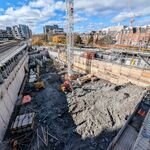Silence&Motion
Senior Member
Hopefully we don't already have a thread on Peter Dickinson. I figured that with all of the debate over his buildings in the Regent Park thread, it might be worth opening a new one here. Also, BlogTO just posted this article on Dickinson:
http://www.blogto.com/city/2011/03/the_lost_architecture_of_peter_dickinson/
One of the questions that arises in a discussion of Dickinson is why we allow so many of his buildings to be demolished and whether or not he deserves more reverence than he receives. Some argue that today the early modern buildings of the late 1950s are in a similar position as the Victorian buildings were in the 1960s. Early modern buildings have fallen out of fashion, but do not yet invoke historical nostalgia, which means that they become ideal candidates for demolition.
The BlogTO article frames Dickinson buildings in ways that are often used to discuss Victorian buildings, arguing essentially that "they don't build them like they used to". The author laments that "to look at [Dickinson's] Benvenuto Apartments... is to see a way of designing buildings that is sadly past," and argues that his buildings have an "undeniable delicacy" to them that presumably cannot be recreated today. This is quite similar to how we describe Victorian architecture (though not necessarily the delicacy part).
Putting aside the issue of whether Dickinson buildings should be preserved, I actually disagree with the parallels being drawn between Victorians and early modernism. We really DO NOT build Victorian buildings anymore and we are incapable of building them even if we wanted to. We lack the materials, the technology, and the skills that allow us to build Victorian buildings in any realistic way. There are not too many stonemasons living in Toronto these days. There's barely any stone. The stock of Victorian buildings we currently have is all we will ever get, which places more pressure on us to preserve them.
By contrast, we actually DO build and design buildings in essentially the same way as we did in the early modern era. Sure there have been some small technological and aesthetic changes, but the basic architectural language and construction practices are the same. Architectural buffs may have a detailed enough understanding of the field to identify the subtleties that distinguish a Dickinson from other modern buildings, but they cannot say that the aesthetic variation between early modernism and contemporary modernism in anyway approaches the variation between modern and Victorian. And they definitely will have a hard time arguing that most of the aesthetic successes achieved by Dickinson cannot be reproduced by today's architects and construction industry.
What does this mean in terms of preservation? My personal inclinations are actually in favour of preserving the Dickinsonians for historical reasons. But I doubt we will ever see the same kind of public pressure to preserve early modernism as we do with Victorian buildings – at least not until we see another major transition in the way we construct buildings (possibly due to environmental pressures such as peak oil).
http://www.blogto.com/city/2011/03/the_lost_architecture_of_peter_dickinson/
One of the questions that arises in a discussion of Dickinson is why we allow so many of his buildings to be demolished and whether or not he deserves more reverence than he receives. Some argue that today the early modern buildings of the late 1950s are in a similar position as the Victorian buildings were in the 1960s. Early modern buildings have fallen out of fashion, but do not yet invoke historical nostalgia, which means that they become ideal candidates for demolition.
The BlogTO article frames Dickinson buildings in ways that are often used to discuss Victorian buildings, arguing essentially that "they don't build them like they used to". The author laments that "to look at [Dickinson's] Benvenuto Apartments... is to see a way of designing buildings that is sadly past," and argues that his buildings have an "undeniable delicacy" to them that presumably cannot be recreated today. This is quite similar to how we describe Victorian architecture (though not necessarily the delicacy part).
Putting aside the issue of whether Dickinson buildings should be preserved, I actually disagree with the parallels being drawn between Victorians and early modernism. We really DO NOT build Victorian buildings anymore and we are incapable of building them even if we wanted to. We lack the materials, the technology, and the skills that allow us to build Victorian buildings in any realistic way. There are not too many stonemasons living in Toronto these days. There's barely any stone. The stock of Victorian buildings we currently have is all we will ever get, which places more pressure on us to preserve them.
By contrast, we actually DO build and design buildings in essentially the same way as we did in the early modern era. Sure there have been some small technological and aesthetic changes, but the basic architectural language and construction practices are the same. Architectural buffs may have a detailed enough understanding of the field to identify the subtleties that distinguish a Dickinson from other modern buildings, but they cannot say that the aesthetic variation between early modernism and contemporary modernism in anyway approaches the variation between modern and Victorian. And they definitely will have a hard time arguing that most of the aesthetic successes achieved by Dickinson cannot be reproduced by today's architects and construction industry.
What does this mean in terms of preservation? My personal inclinations are actually in favour of preserving the Dickinsonians for historical reasons. But I doubt we will ever see the same kind of public pressure to preserve early modernism as we do with Victorian buildings – at least not until we see another major transition in the way we construct buildings (possibly due to environmental pressures such as peak oil).




